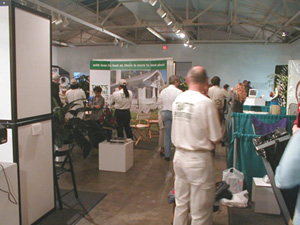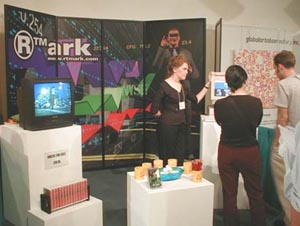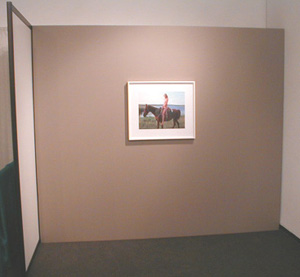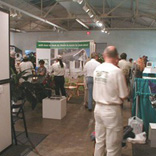One of Houston’s more jaw-dropping gaffes on the national stage was a recent promotional insert in the New York Times which only mentioned Houston’s art scene with the following rather facile conjunction: “Oil: A Strategic Reserve for Art and Energy.”
Sure, we do oil derricks, but we also do oil on canvas. Our art scene is as rich as the oil business that made us famous.” The admen who came up with this copy did at least manage to obliquely (and surely unintentionally) hit upon an especially provocative node of inquiry for contemporary art. To the Trade at Diverseworks employed both a critical edge and a quirky sense of humor to set in motion a dialogue about the complex relationships between art and economics.
Billed as a “trade show for the art industry”, To the Trade brought together a motley group of artists who position themselves as service providers. Curators Bernard Brunon and Jade Dellinger conceived of the exhibition’s trade show format seven years ago in a stroke of brilliance that has maintained its relevance, despite several incarnations of the idea having been cancelled by potential host institutions. With artists or their representatives manning professional trade booths on the night of the opening and with services and products available for purchase in “realtime” on the spot, the exhibition actually constituted a functional trade show in addition to mounting a convincing performance of the conventions of that domain. It was unfortunate — but unavoidable — that the show lost much of its vigor once the artists/performers departed after opening night. Just as in an ordinary trade show, plastic bags stuffed with literature about the event and its sponsors were placed at the entrance to the gallery-turned-exposition hall. By the end of a cruise by all fifteen booths, any good hoarder could manage to amass in his or her bag a formidable collection of postcards, flyers, pencils, brochures, keychains, chip clips, and bottle-cozies — in short, the usual throwaway, forgettable debris of the trade show experience.
The artists in the show peddled a wide range of services as well as a disparate array of conceptions — from the concrete to the abstruse — of what might in fact constitute a service. Soussan, Ltd., a French company that provides signage, security, transport, catering, and other services to the art industry displayed MBRHAERS.2001.00, a blue trash bin ‘specially made for use in exhibition areas or anywhere that an element of design is important.” As unwieldy as its name, the bin hardly required the postcards and signage that proclaimed “this is not a work of art this is a trash can.” The bin nevertheless pointed towards a concept Soussan Ltd. understands well: the museum as an aesthetically micro-managed environment. Soussan Ltd. provides fire extinguishers to their clients in precisely customized shades of red, indicating that outfitting a museum is a kind of installation art, a position reflected in the company’s motto, “Furnishing museums, the work of artists”.
Both Andrea Blum and Nicholas Floc”h offered modular furniture designs that recalled the work of Andrea Zittel, whose A-Z lines epitomize the kind of work well suited to this exhibition. Blum displayed pared-down, efficient designs for a mobile art display unit and a portable library carrel for art books. The carrel is designed for two readers to sit opposite from each other in privacy except for a window that exposes their hands and reading material. Nicholas Floc”h presented a portable kit of furniture designed to travel with art exhibitions. Constructed with a material Floc”h calls Functional Floor, the kit includes a welcome desk, seating, and even a tray for serving drinks at receptions.
Both [The Thing] and zingmagazine presented artists involved in providing media outlets to other artists as venues for their work. [The Thing] is a website that posts reviews, special projects, and commentary in addition to providing webhosting services. The content of quarterly zingmagazine is largely orchestrated by one-time “curators” (a usage of that term editor Devon Dikeou has trademarked) who are given many-page spreads to manage as they choose.
Several artists presented projects enabling public access to the creative process, at a price. Fal-Con International, a company run in Lubbock, Texas by artists Will Canning and William R. Howe, operates a multifaceted campaign to preserve and explore “automotive ephemera.” Fal-Con invites the public to send car parts as well as detritus from road trips (receipts, coffee cups, found objects) for cataloguing and eventual museum display. The company also packages and sells defunct automotive parts in various “product lines” as both artifacts and art objects.
Lucy Orta displayed the physical evidence of 70 x 7 The Meal, a performative concept she has executed in conjunction with museums in several countries: “70 x 7 is a meal for seven guests to invite seven more, who in turn invite seven … A recipe for conviviality where an infinite number of new encounters begin.” Similar in its aims to Lee Mingwei’s The Dining Project, 70 x 7 “introduces the theme of the meal as a ritual for public exchange”. Orta’s work calls into question the divides between art, activism, and, it must be said, party planning. Available for purchase at about $100 apiece, the Royal Limoges porcelain plates commissioned for the meals displayed a vapid, cloying idealism in the seemingly heartfelt but nevertheless clichéd collection of words that circled the plates: paix, respect, amistad, liberté, freundschaft, exchange, coeur, and so on.
Both Gaylen Gerber and That’s Painting Productions presented work that probes the boundaries of painting as a discipline. Gaylen Gerber was the only artist in the exhibition to dispense with the most elementary trappings of trade show presentation (such as a prominently placed name and logo) in favor of a display that seemed better suited for a gallery environment. This underscored Gerber’s position as the provider of what was the show’s least accessible, least commercial, and most brainily conceptual service: the opportunity to collaborate with him by painting or otherwise covering over some or all of a neutrally-painted canvas that he provides. Gerber considers each of his monochromatic neutral paintings to be “both a meaningful object in its own right and a ground against which the other meanings emerge.” While Gerber invites direct participation in his conceptual enterprise by only a select few, That’s Painting Productions explores similar ideas by making its services available to the masses on a contract basis. Founded by Bernard Brunon, co-curator of To the Trade, That’s Painting is a real house painting company that provides its services at competitive market prices. Arguing that his work is installation art, Brunon notes that “to paint a room is not to depict it, it is to inscribe it in its real space.” Aligned with a theoretical climate in which little in our understanding of our experiences and the social world can be taken as unproblematically given, Gerber, Brunon, and even Soussan Ltd. investigate the very ideas of background, context, and object and their conventional subordination to concepts of art and the subject.
lacked in friendliness, it made up for in excellent whiskey”]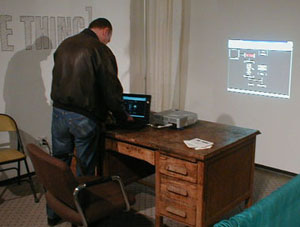
Artists in To the Trade displayed a curiously broad variation in the seeming levels of cynicism with which they viewed their involvement in the capitalist economic system. Firmly anchoring one end of the spectrum was ®™ark, an actual limited liability corporation in which anonymous investors sponsor acts of corporate sabotage. ®™ark ‘s great brilliance lies in its full mastery of the panoply of corporate strategies for self-presentation, from impenetrable lingo which evades all implication of personal responsibility, to futuristic, high-tech graphics, to artist Lenore Stanley’s stunning, imperturbable performance at the opening as a minion of corporate doublespeak. While ®™ark ‘s subversions place them perilously close to legal action at all times, both globalartobservatory (gao) and Local Access offered what were to all appearances earnest and uncritical (if ambiguous) efforts to bridge the gap between art and industry. Tampa-based gao describes itself as “a private art agency serving to develop innovative models for cooperation between Art, Business, and the Media in order to facilitate an exchange of resources which will mutually enhance each group.” Founded by Phillipe Mairesse, French organization Local Access asks seeks bring art and industry into dialogue about each of their respective strengths. In what seems to be an incredibly generous and idealistic perception of the degree to which the art world is taken seriously in the world of business, Local Access claims to inquire into what role contemporary art can “play in the creation of a new creative synergy for modern economic thought.”
To the Trade succeeded because the trade show format was at least as trenchant as it was novel. Artists have never been a world apart from economics. Trade shows are nothing more than slick, corporate versions of bazaars and traveling circuses, and the positioning of artists in this market format responds wittily to the penetration, whether real or imagined, of the global capitalist economy into all the nooks and crannies of life. We live at a moment in which arts organizations routinely defend their existence with studies that demonstrate the positive correlation between cultural activity and economic strength, a claim that is dispiriting in much the same way as scientific proof of the efficacy of prayer. What’s more, it is now possible for an artist to conceive of himself or herself as, in Mairesse’s words, “a network man, looking for producers, whose projects need heterogeneous investment to be set up, … the manager of the mini-firm he represents as an individual.” The unabashed identification of the To the Trade as a realm of commerce and of its artists as service providers was a cogent instantiation of a broader, de-sacralizing movement of forging real and metaphorical connections between visual art and other, once-distant realms. The trade show format of To the Trade provides tremendous flexibility for the exhibition to organically change and grow in response to “market forces.” Here’s hoping this newfangled band of traveling salespeople will find subsequent venues for plying their trade.
Maria Stalford lives in Houston, TX.


